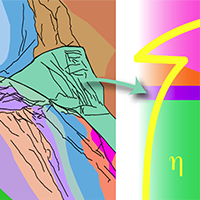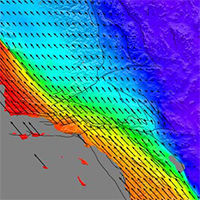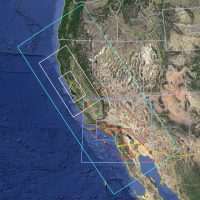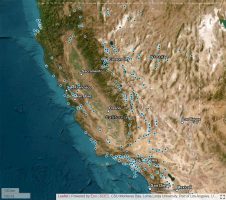Identifying critical datasets and organizing the community of volunteers working to update and extend the Geological Framework Model (GFM) and Community Thermal Model (CTM)
Date: August 14-15, 2025
Location: University of California, Davis
Workshop Organizers: Mike Oskin (UC Davis), Andrew Zuza (UNR), Terry Lee (UNR), Laurent Montesi (U Maryland), Oliver Boyd (USGS), Yuehua Zeng (USGS), Sierra Rack (UC Davis)
SCEC Award: 25340
Developing Community Earth Models (CEMs) is a major activity of the Statewide California Earthquake Center (SCEC). With SCEC’s statewide expansion, there is an urgent need to broaden the geographic scope of these models. Among the CEM components, the Geological Framework Model (GFM) and Community Thermal Model (CTM) are foundational products that support other models, such as the Community Rheology Model (CRM), and provide a critical framework for interpreting velocity, geodetic, and stress data. To advance these efforts, a joint GFM-CTM workshop was held at UC Davis that brought together 35 researchers to identify key datasets and organize volunteers to update and extend these models across California. GFM discussions focused on (1) extending existing lithotectonic provinces and defining new ones for Northern California, (2) incorporating major three-dimensional features such as dipping boundaries, deep sedimentary basins, and sub-province crustal variations, and (3) developing upper mantle models consistent with tomographic and thermal constraints. Contributions were solicited from allied efforts at USGS and CGS. CTM discussions highlighted decades of progress in thermal modeling, assessed observational constraints and modeling techniques, and examined existing models for their relevance to evaluating seismicity and related applications. Participants reviewed the current state of CTMs, explored options for accessing existing models, and generated new ideas for future updates. Feedback also addressed the role of CTMs within the broader SCEC Community Earth Model (CEM) framework.
All times are Pacific Daylight Time (UTC-7).
Presentation materials may be viewed by clicking the links below. PLEASE NOTE: Files are the author’s property. They may contain unpublished or preliminary information and should only be used for reviewing the talk. Only the presentations for which SCEC has received permission to post publicly are included below.
| Time | Agenda Item | Speaker | |
|---|---|---|---|
| 09:00 - 09:15 | Session 1: Introduction, logistics, and objectives | ||
| 09:15 - 10:15 | Session 2: GFM/CTM reviews, comparison, and validation | ||
| 09:15 - 09:35 | A statewide geological framework | Mike Oskin & Sierra Rack (UC Davis) | |
| 09:35 - 09:45 | Discussion | ||
| 09:45 - 10:05 | Russ Graymer (USGS) | ||
| 10:05 - 10:15 | Discussion | ||
| 10:15 - 10:30 | Break | ||
| 10:30 - 10:50 | Updates on the CTM (PDF) | Terry Lee (UNR) | |
| 10:50 - 11:10 | Conterminous United States thermal models (PDF) | Oliver Boyd (USGS) | |
| 11:10 - 11:30 | Community models: From geology to rheology (PDF) | Laurent Montesi (U. Maryland) | |
| 11:20 - 11:30 | Discussion | ||
| 11:30 - 12:00 | General Discussion | ||
| 12:00 - 13:00 | Lunch Break | ||
| 13:00 - 15:45 | Session 3: Contributed talks | ||
| 13:00 - 13:06 | A geologically-consistent 3D thermal model of central and southern California | Ángela Maria Gómez Garcia | |
| 13:06 - 13:12 | Integrating 3D geologic framework information into Macrostrat's descriptive Earth model | Daven Quinn (UW– Madison) | |
| 13:12 - 13:18 | The geologic framework in the USGS National Crustal Model for seismic hazard studies (PDF) | Oliver Boyd (USGS) | |
| 13:18 - 13:24 | 1:24:000 scale geologic mapping in the northern Walker Lane, NW Nevada. | Ryan Goldsby (UNR / Nevada Bureau of Mines and Geology) | |
| 13:24 - 13:30 | Coupling diverse datasets to develop a 3D structural model of the San Joaquin Fold-and-Thrust Belt | Robert Welch (Loyola Marymount University/Harvard) | |
| 13:30 - 13:36 | Do borehole breakouts tell us about regional stress or local structures? | Sarah Titus (Carleton College) | |
| 13:36 - 13:42 | Work toward multiscale statewide CVM (PDF) | Yehuda Ben-Zion (USC) | |
| 13:42 - 13:48 | Characterization of heat flow and fault zone properties in eastern California | Zachary Smith (UC Berkeley) | |
| 13:48 - 13:54 | Lower seismogenic depth model for western US earthquake ruptures (PDF) | Yuehua Zeng (USGS) | |
| 13:54 - 14:15 | General discussion | ||
| 14:15 - 14:30 | Break | ||
| 14:30 - 15:45 | Contributed talks continued | ||
| 14:30 - 14:42 | Active tectonics in northern California and the evolving lithospheric thermal structure (PDF) | Kevin Furlong (Penn State) | |
| 14:42 - 14:54 | Christie Rowe (UNR) | ||
| 14:54 - 15:00 | Low-frequency earthquakes track the evolution of a captured slab fragment | Amanda Thomas (UC Davis) | |
| 15:06 - 15:12 | A rock-centric framework for earthquake dynamics and its applications in southern California | Binhao Wang (USC) | |
| 15:12 - 15:18 | Near-surface (<1-km depth) location and characterization of faulting with 30-minute surveys (PDF) | John Louie (Terēan) | |
| 15:18 - 15:24 | ShakeAlert in the Age of AI: Using DL to Predict Station Failure using State of Health Data | Fabia Terra (UC Berkeley) | |
| 15:24 - 15:30 | A compilation of velocity models for central California | Gary Fuis (USGS) | |
| 15:30 - 15:45 | General discusion | ||
| 15:45 - 16:00 | Break | ||
| 16:00 - 17:30 | Session 4: Breakouts | ||
| Breakout #1: Discussion of major lithotectonic units of northern CA | |||
| Breakout #2: Discussion of CTM methods and comparisons | |||
CEMs are collaborative platforms featuring community-contributed data, models, and tools for earthquake system analysis. They enable 3D visualization, data exploration, sharing, and integrated modeling.

Community Rheology Model (CRM) Viewer
3D ductile rheology of lithosphere in S. California

Community Geodetic Model (CGM) Explorer
Earth surface displacement from GNSS and InSAR

Community Fault Model (CFM) Explorer
3D geometric representations of faults in California

Unified Community Velocity Model (UCVM)
seismic velocities for several California regions

Community Stress Model (CSM) Explorer
suite of models of stress and stressing rate

Geologic Slip Rate Database (GSRD)
geologic slip rates for CA, NV, and northern Mexico

Precariously Balanced Rock (PBR) Database
field-derived data for PBRs in California
All times are Pacific Daylight Time (UTC-7).
| Time | Agenda Item | Speaker | |
|---|---|---|---|
| 08:30 - 09:00 | Session 1: Introduction and recap of Day 1 | ||
| 09:00 - 10:00 | Session 2: Invited overview CFM | ||
| 09:00 - 09:25 | CFM and CEM (PDF) | Scott Marshall (Appalachian State) | |
| 09:25 - 09:50 | Crescent community models | Becky Fildes (Western Washington University) | |
| 09:50 - 10:15 | The San Francisco Bay Area CVM | Evan Hirakawa (USGS) | |
| 10:00 - 11:30 | Session 3: Breakout discussions on either GFM or CTM | ||
| Breakout #1: Moving forward with GFM | |||
| Breakout #2: Moving forward with CTM | |||
| 11:30 - 12:00 | Wrap up | ||
| 12:00 | Workshop Adjourns | ||
* Remote Participant
| Last Name | First Name | Organization |
|---|---|---|
| Aguilar | Brian | CSU Bakersfield |
| Arnow | Alec | UC Davis student |
| Ben-Zion | Yehuda | USC/SCEC |
| Boyd | Daniel | California Geological Survey |
| Boyd | Oliver | USGS |
| Boyd | Sierra | Berkeley Seismological Laboratory |
| *Dunham | Eric | Stanford University |
| Elbanna | Ahmed | University of Southern California |
| Fildes | Becky | Western Washington |
| Furlong | Kevin | Penn State Univerisity |
| Goldsby | Ryan | UNR |
| *Gómez Garcia | Ángela Maria | CSIC/GFZ |
| *Graymer | Russell | USGS |
| Hirakawa | Evan | USGS |
| Hwang | Lorraine | UC Davis CIG |
| *Langenheim | Victoria | USGS |
| Lee | Wai Ho (Terry) | University of Nevada, Reno |
| Louie | John | Terēan |
| *Marshall | Scott | Appalachian State |
| Martin | Hannah | Nevada Seismological Laboratory, UNR |
| Montesi | Laurent | University of Maryland |
| Oskin | Michael | UC Davis |
| Quinn | Daven | UW–Madison |
| Rack | Sierra | UC Davis |
| Rowe | Christie | UNR - Nevada Seismo Lab |
| Smith | Zachary | University of California Berkeley |
| Terra | Fabia | UC Berkeley |
| Thomas | Amanda | UC Davis |
| Tian | Xiaochuan | UC Davis |
| Titus | Sarah | Carleton College |
| Wang | Binhao | University of Southern California |
| Welch | Robert | Loyola Marymount University/Harvard University |
| Young | Elaine | California Geological Survey |
| Zeng | Yuehua | USGS |
| Zuza | Andrew | University of Nevada, Reno |
The Statewide California Earthquake Center (SCEC) fosters a diverse and inclusive community where everyone feels safe, productive, and welcome. We expect all participants in SCEC-supported events to uphold this commitment by adhering to the SCEC Activities Code of Conduct.
The SCEC Annual Meeting brings together 400-500 participants worldwide to share breakthroughs, assess progress, and chart a collaborative path for earthquake science. All of the Center activities are presented, analyzed, and woven into a set of priorities for SCEC to pursue in the future.